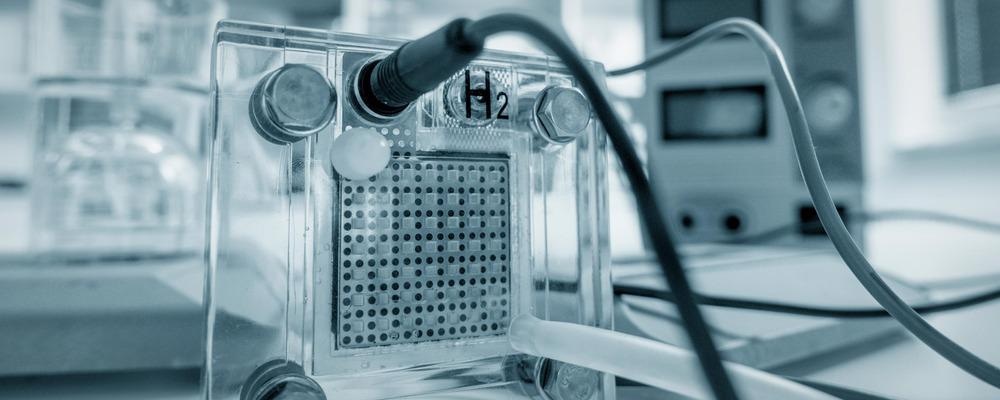Proton exchange membrane fuel cells (PEMFC) offer excellent potential for use in a wide range of energy-conversion technologies.

Image Credit: luchschenF/Shutterstock.com
Unlike batteries which exhibit limited working lives, fuel cells produce energy and heat as long as fuel is supplied. Proton exchange membrane fuel cells are typically able to operate at temperatures of 80 °C to 100 °C, offering significant advantages over traditional high-temperature fuel cells including relatively short warm-up periods.
PEMFCs are able to rapidly vary their output to accommodate ever-changing energy demands, and depending on the fuel type employed, PEMFCs are also considered to be more environmentally friendly than their traditional battery-based counterparts.
Despite these diverse advantages, there remains an ever-present risk of ‘CO poisoning’ whereby fuel cell performance is adversely affected by degradation of the expensive platinum catalyst, resulting from the presence of even minimal levels of carbon monoxide (CO) in the fuel gas.
CO poisoning affects the anode reaction as the CO preferentially adsorbs to the platinum surface, therefore blocking active sites and impacting performance.
As little as tens of parts per million of CO can effectively poison a pure platinum catalyst. This CO poisoning effect is slow, however, and can be reversed using appropriate techniques.
While this effect is not present in PEMFCs that utilize pure hydrogen, the use of pure hydrogen is impractical and unrealistic for most applications.
A number of methods have been historically employed in the minimization of CO poisoning risk, particularly the use of a platinum alloy catalyst, the introduction of oxygen into the fuel gas flow and the use of higher cell operating temperatures. These methods have seen limited success, however.
Seeking to provide a viable alternative to highly CO-sensitive and expensive platinum catalysts, recent research into a new class of IrRu-N-C catalysts has made use of Ir and Ru single atoms that have been uniformly populated in nitrogen-carbon composites.
These catalysts provide extremely high-efficiency single-atom catalysis towards H2 electrooxidation while demonstrating robust CO electrooxidation reaction (COOR) behavior which initiates at approximately 0 mV – a notable difference when compared with a reversible hydrogen electrode at ambient temperature.
These properties afford this new catalyst impressive CO anti-poisoning potential when employed in proton exchange membrane fuel cells, even when used in combination with ultra-low noble metal loading.
Using a mixture and physical probing techniques and theoretical calculations to investigate their potential, this distinct class of atomically dispersed IrRu-N-C anode catalysts was found to exhibit excellent potential to oxidize either or both CO and H2.
Operating with just 24 μg of metal per cm−2 in the anode, the H2 fuel cell was noted to exhibit peak power density at 1.43 W per cm−2; while operating with pure CO saw this catalyst exhibit maximum current density at 800 mA per cm−2.
The complex interplay between Ir and Ru single-atom centers was found to be central to this catalytic behavior, whereby the sites acted synergistically to decompose H2O and facilitate additional CO activation.
PEMFCs are a popular choice for transportation applications due to their high power density, lightweight and favorable impact on the environment (due to their potential to help reduce greenhouse gas (GHG) emissions).
PEMFCs remain the optimal choice for small-scale systems until a means of supplying economically scalable pure hydrogen is developed. Despite their current limitations, PEMFCs also offer excellent potential to ultimately supersede batteries for portable electronic devices.
Because of PEMFCs’ centrality to so many emerging technologies and industries – not least the urgent need to move away from the use of fossil fuels across all sectors - the impact of these findings and the potential to effectively address the ongoing issue of CO poisoning in PEMFCs cannot be overstated.
This development could considerably improve the reliability, applicability, and potential of these already widely used power sources.
Most notably, the development of PEMFCs that are not reliant on expensive platinum catalysts could see their use increase dramatically, as these promising devices become more cost-effective and easier to produce at scale.
Journal Reference:
Xian Wang, Yang Li, Ying Wang, Hao Zhang, Zhao Jin, Xiaolong Yang, Zhaoping Shi, Liang Liang, Zhijian Wu, Zheng Jiang, Wei Zhang, Changpeng Liu, Wei Xing, Junjie Ge. (2021).
Proton exchange membrane fuel cells powered with both CO and H2. 118 (43) e2107332118; DOI: 10.1073/pnas.2107332118 https://www.pnas.org/content/118/43/e2107332118.short
Disclaimer: The views expressed here are those of the author expressed in their private capacity and do not necessarily represent the views of AZoM.com Limited T/A AZoNetwork the owner and operator of this website. This disclaimer forms part of the Terms and conditions of use of this website.